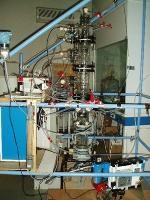Indoor air and flue gas treatment - Particle transport

Treatment of indoor air and gaseous effluents
LaTEP began its research activities on the Treatment of air and industrial gaseous effluents in the early 2000s. Over the past four years, it has boosted its involvement in the study into two types of process: physico-chemical processes (more specifically adsorption) and biological processes, in particular biofiltration. Air pollution is now known to cause cancer in human beings and is responsible for a large number of deaths; it has become a major problem on a global scale. Consequently, the work carried out in Tarbes in recent years has focused mainly on the treatment of indoor air.
Air pollution is characterized by a considerable number of pollutants, with very different physicochemical properties, at extremely low concentrations and rapidly variable over time. Nevertheless, a certain number of these pollutants remain above the threshold values deemed acceptable for the health. The study of systems that can treat such pollution involves highly accurate knowledge of the composition of the gas requiring decontamination. Throughout these years of research, we have acquired recognized skills in the generation and analysis of multi-component and micro-polluted gases.
For example, between 2008 and 2010, we conducted comprehensive physico-chemical tests of new on-board filters designed to improve the air quality in the passenger compartments. These tests were carried out under realistic conditions on a special test bench used to generate and analyze confined atmospheres containing extremely low concentrations of pollutants (of ppb order of magnitude).
Our work has shown that biofiltration, used up until now for treating certain industrial gaseous effluents, was also capable of treating a wide range of air pollutants (in particular a large proportion of VOCs). It also demonstrated that biological processes offered very interesting prospects for cleaning up the air in confined areas (living spaces and transportation means), where Westerners spend 80% of their time.
By studying filter media composed of waste (green waste compost or manure, sewage sludge), we hope to develop solutions that are efficient, inexpensive, easy to use and environmentally friendly. Such porous media play a decisive role in the process. They offer the added advantage of containing an endogenous biomass, thereby eliminating the prior complex seeding phases. The complex cocktail of air pollutants means that no single process has been able to satisfactorily and effectively treat indoor air so far. Only by coupling different processes can we broaden the spectrum of eliminated pollutants and effectively treat both background pollution and the unavoidable emission peaks caused by human activities. For a few years now we have been working on coupling a biofilter with a complementary process, adsorption (on activated carbon).
During these years of research, we attempted to deepen our understanding of the complex phenomena that are at stake, which is why our work has always involved both the experimental and theoretical aspects: biofiltration and adsorption processes were modeled in an attempt to better understand the phenomena involved, which can be very different from those that develop at much higher concentrations than those usually encountered.
As regards the modeling, we studied sequential adsorption coupling on zeolites - regeneration by ozonation in the treatment of gaseous organic effluents. We also developed a model for the reactive adsorption of nitrogen dioxide (NO2) on activated carbon, in the range of concentrations found in indoor air.
The study of fluid / solid material transfer was also deliberated during that time, with applications in the fields of metrology and air treatment. One of the topics covered involves the sampling of VOCs in the air by adsorption on SPME (Solid Phase Micro-Extraction) fibers. Another topic relates to the study of how building materials impact indoor air quality.
Particle Transport - Coupled Transfer Phenomena
Knowledge of the basic phenomena involved between a fluid sphere and an external flow is important for understanding transfers in liquid-liquid, solid-liquid and gas-liquid systems in the fields of chemical, petrochemical or biochemical engineering as well as in the field of environmental engineering. Hydrodynamics strongly influence the transfer of heat and / or matter between inclusions and external flow. With regard to coupled transfers in dispersed media, two studies were conducted over the relevant period. The first involves a parametric study on particle transport in a ventilated room. As part of this work, the evaporation of a drop (liquids with different characteristics) less than 1 mm in diameter, falling freely through the air was studied experimentally. This led to the development of a model based on equations describing the relation between the particle and the transfer of matter and heat between the drop and the air. Current work involves the study of the effect of the viscosity ratio k (k = μ d / μc) on the transfer of matter / heat between a spherical particle and a continuous medium, with a view to putting forward correlations to determine internal and external transfer coefficients.
Framework of Studies: International partnerships with the Institute for Nuclear Technology and Other Mineral Raw Materials, Department of Chemical Engineering / Belgrade (Serbia and Montenegro), Department of Chemical Engineering, Sofia University of Chemical Technology and Metallurgy ( Bulgaria); national partnerships with the Laboratoire de Génie Chimique de l’INPT (INPT chemical engineering laboratory) and UPPA's SIAME laboratory.